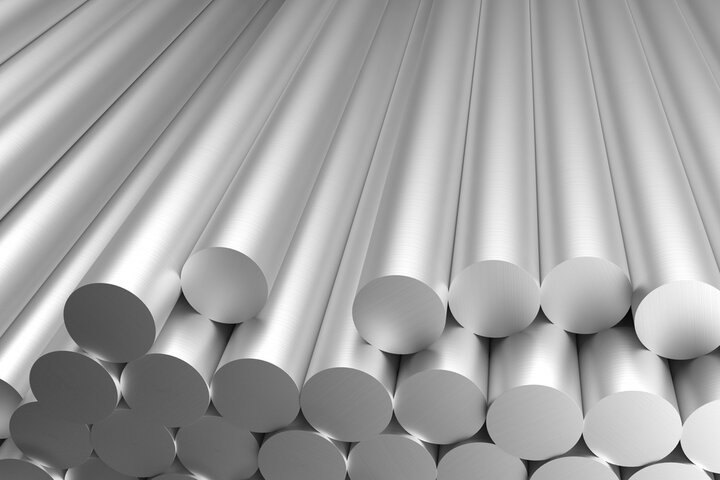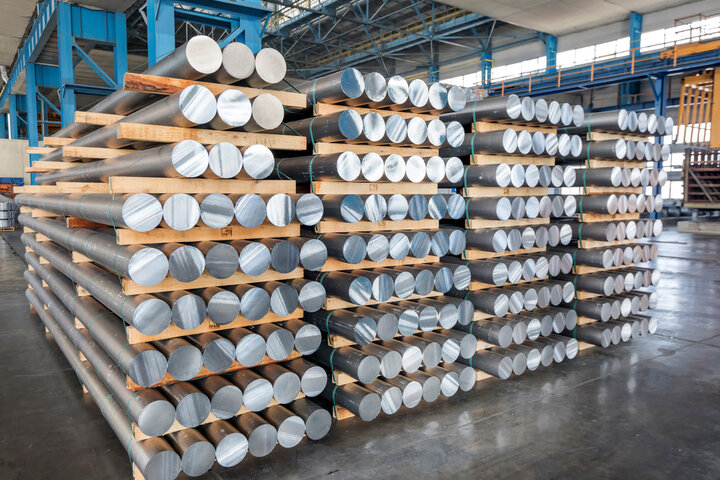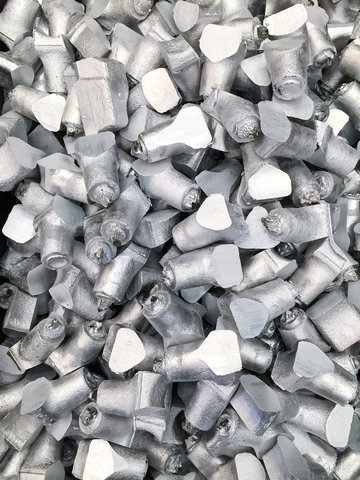Aluminum is a versatile material crucial in industries like aerospace, automotive, and manufacturing. But not all aluminum is created equal. Should you choose billet, cast, or forged aluminum for your next project? Understanding the differences can greatly impact performance, cost, and durability.
In this post, we’ll break down the strengths and weaknesses of each aluminum type. You’ll learn how billet, cast, and forged aluminum differ in strength, machinability, and ideal applications.

Aluminum Alloys
Aluminum alloys are created when aluminum is combined with other metals or elements. This process enhances aluminum's natural properties, making it more versatile for various applications. Alloying helps improve its strength, corrosion resistance, and machinability.
What Makes Aluminum Alloys Special?
Pure aluminum offers excellent corrosion resistance and lightweight properties. However, it lacks the strength needed for demanding applications. Adding specific elements creates alloys with superior characteristics:
Enhanced mechanical strength suitable for aerospace components and automotive structural parts
Improved machinability essential for precision manufacturing and complex design requirements
Better heat resistance critical for high-temperature applications and thermal processing
Increased durability necessary for long-term performance in challenging environments
Key Alloying Elements and Their Impact
Different elements contribute unique properties to aluminum alloys:
| Element | Primary Benefits | Common Applications |
| Copper | Increases strength and hardness | Aircraft components, automotive parts |
| Magnesium | Improves corrosion resistance and weldability | Marine equipment, pressure vessels |
| Silicon | Enhances casting properties and reduces melting point | Complex castings, automotive pistons |
| Zinc | Boosts strength and stress resistance | Aerospace structures, high-stress components |
Different Series of Aluminum Alloys and Their Characteristics
Aluminum alloys are grouped into series based on the primary alloying element. Each series offers distinct properties:
1000 Series: Composed of pure aluminum, offering excellent corrosion resistance but lower strength.
2000 Series: Copper is the main alloying element, providing high strength but reduced corrosion resistance.
3000 Series: Manganese is the primary alloying element, offering moderate strength with good workability.
5000 Series: Magnesium is the main alloying element, enhancing strength and corrosion resistance, often used in marine applications.
6000 Series: A versatile series combining magnesium and silicon for good strength, machinability, and weldability.
7000 Series: Zinc is the primary alloying element, delivering the highest strength, often used in aerospace.
What Are The Three Types of Aluminum Manufacturing?
Aluminum can be produced using three main methods: casting, billeting, and forging. Each manufacturing process offers unique strengths and characteristics, making it essential to choose the right type for specific applications. Here’s a breakdown of the three processes:
Cast Aluminum Explained
Cast aluminum emerges from molten metal poured into predefined molds. This versatile process enables complex shapes through controlled solidification.
Manufacturing Steps
Heating A380 aluminum alloy beyond its melting point (1,100°F)
Pouring liquefied metal into prepared mold cavities
Allowing metal to cool and solidify under controlled conditions
Removing cast parts for final finishing operations
A380 Composition and Properties
| Element | Percentage | Property | Value |
| Aluminum | 80.3-89.5% | Tensile Strength | 47,000 PSI |
| Silicon | 7.5-9.5% | Yield Strength | 23,100 PSI |
| Copper | 3.0-4.0% | Hardness (Brinell) | 80 |
| Zinc | Up to 3.0% | Shear Strength | 26,800 PSI |
Primary Applications
Automotive components require complex internal geometries and cost-effective production
Consumer products benefit from rapid manufacturing and design flexibility
Industrial equipment parts need economical production in large quantities
Billet Aluminum Basics
Billet aluminum starts as solid metal stock machined into precise components. CNC processes transform raw material into finished parts.
6061-T6 Properties
| Component | Percentage | Characteristic | Rating |
| Aluminum | 95.8-98.6% | Tensile Strength | 45,000 PSI |
| Magnesium | 0.8-1.2% | Yield Strength | 40,000 PSI |
| Silicon | 0.4-0.8% | Hardness (Brinell) | 95 |
| Copper | 0.15-0.4% | Shear Strength | 30,000 PSI |
Manufacturing Process
Extruding aluminum into standardized shapes
CNC machining removes material to create final geometry
Heat treating to achieve T6 temper specifications
Surface finishing for appearance and protection
Common Applications
Aerospace components demand high precision and consistent material properties
Marine equipment requires excellent corrosion resistance and strength
Precision instruments need exact tolerances and surface finish quality
Forged Aluminum Overview
Forged aluminum undergoes intense pressure shaping. This process aligns internal grain structure for maximum strength.
7075-T6 Composition
| Element | Percentage | Property | Value |
| Aluminum | 87.1-91.4% | Tensile Strength | 83,000 PSI |
| Zinc | 5.1-6.1% | Yield Strength | 73,000 PSI |
| Magnesium | 2.1-2.9% | Hardness (Brinell) | 150 |
| Copper | 1.2-2.0% | Shear Strength | 48,000 PSI |
Manufacturing Details
Heating aluminum billets to optimal forging temperature
Applying controlled pressure through specialized dies
Shaping metal while maintaining precise temperature control
Heat treating to enhance mechanical properties
Key Applications
Aircraft structural components require maximum strength and fatigue resistance
Heavy machinery parts need superior impact resistance and durability
High-stress automotive components demand reliable performance under load
Each manufacturing method offers unique advantages. Selection depends on specific application requirements, budget constraints, and performance needs.

Comprehensive Comparison: Billet vs Cast vs Forged Aluminum
| Characteristic | Billet Aluminum | Cast Aluminum | Forged Aluminum |
| Material Properties |
|
|
|
| Tensile Strength | 45,000 PSI | 47,000 PSI | 83,000 PSI |
| Yield Strength | 40,000 PSI | 23,100 PSI | 73,000 PSI |
| Shear Strength | 30,000 PSI | 26,800 PSI | 48,000 PSI |
| Hardness (Brinell) | 95 | 80 | 150 |
| Manufacturing |
|
|
|
| Process | CNC machined from solid stock | Molten metal poured into molds | Compressed under high pressure |
| Material Waste | Higher waste from machining | Minimal waste | Moderate waste |
| Production Speed | Slower | Fastest | Moderate |
| Design Complexity | High precision possible | Most complex shapes possible | Limited by forging dies |
| Performance |
|
|
|
| Grain Structure | Uniform, consistent | Can have porosity | Aligned, dense |
| Internal Defects | Minimal | Most likely | Least likely |
| Impact Resistance | Good | Lowest | Highest |
| Fatigue Resistance | Good | Moderate | Excellent |
| Practical Aspects |
|
|
|
| Cost | Higher | Lowest | Highest |
| Machinability | Excellent | Good | More difficult |
| Surface Finish | Excellent | Requires more finishing | Good |
| Volume Production | Low to medium | High | Low to medium |
| Best Applications |
|
|
|
| Primary Uses | Precision components, marine equipment | Complex shapes, high volume parts | High-stress components |
| Industries | Aerospace, Marine | Automotive, Consumer goods | Aircraft, Heavy machinery |
| Component Types | Custom parts, precision instruments | Engine blocks, complex housings | Structural components |
*Note: Values and characteristics may vary based on specific alloys and manufacturing processes used.
Manufacturing Process Deep Dive
Aluminum manufacturing involves different processes, each offering unique advantages based on strength, precision, and cost. Here’s a detailed look at the manufacturing processes for cast, billet, and forged aluminum.
The Casting Process
Casting is a widely used method that involves pouring molten aluminum into a mold to create complex shapes.
Detailed Casting Steps
Melting the Aluminum: Aluminum is heated in a furnace until it becomes molten.
Pouring into Molds: The liquid aluminum is poured into pre-designed molds, which determine the shape of the final product.
Cooling and Solidification: The metal cools and solidifies, taking the form of the mold.
Finishing: The solidified casting is removed from the mold and then sanded or polished to achieve the desired finish.
Equipment Needed
Furnaces to melt the aluminum.
Molds made of sand, metal, or other materials.
Finishing tools like sanders and grinders for surface polishing.
Quality Control Measures
Porosity checks: Detect gas pockets within the casting.
Dimensional inspections: Ensure the part matches the mold specifications.
X-ray tests: Used for critical components to check internal defects.
Billet Manufacturing
Billet aluminum is produced by extruding or rolling aluminum into solid blocks, followed by CNC machining to achieve high precision.
CNC Machining Process
Extruding Aluminum Blocks: Aluminum is heated and extruded into solid billet forms.
Machining: CNC machines are used to mill the billet into precise shapes and dimensions.
Finishing: Minimal post-processing is needed due to the precision of CNC machining.
Tooling Requirements
CNC machines: For precision cutting and shaping.
High-quality dies: To ensure uniform extrusion.
Cutting tools: Specific for working with aluminum alloys, ensuring smooth finishes.
Precision Considerations
Billet aluminum allows for tight tolerances, making it ideal for high-performance parts.
Consistent grain structure: Reduces the chance of internal flaws, ensuring structural integrity.
Forging Techniques
Forging aluminum involves shaping solid aluminum through the application of extreme pressure.
Forging Methods
Open-die forging: Involves shaping aluminum between flat dies, suitable for large parts.
Closed-die forging: Uses shaped dies to compress the metal into specific forms, ensuring precision.
Press forging: Slowly applies pressure, ideal for large aluminum components.
Equipment Requirements
Forging presses: Capable of exerting immense pressure on the aluminum.
Heat sources: To bring the aluminum to the desired forging temperature.
Precision dies: To shape the metal according to the required specifications.
Quality Assurance
Grain alignment tests: Ensure the internal structure of the metal is consistent.
Ultrasonic testing: Used to detect any internal flaws or voids within forged parts.
Tensile strength tests: Verify that the final product meets the required strength standards.
| Process | Key Steps | Equipment | Quality Control |
| Casting | Melting, pouring into molds, cooling, finishing | Furnaces, molds, finishing tools | Porosity checks, dimensional inspections |
| Billet | Extrusion, CNC machining, finishing | CNC machines, dies, cutting tools | Tight tolerances, grain structure checks |
| Forging | Heating, press forging, grain alignment | Forging presses, heat sources, dies | Grain alignment tests, tensile strength |
By understanding the manufacturing process in detail, you can better choose the right aluminum type for specific applications, ensuring optimal performance and cost-efficiency.

Factors to Consider When Choosing Aluminum Type
Selecting the right aluminum type requires careful evaluation of multiple factors. Each manufacturing method offers distinct advantages for specific applications. Let's examine key considerations for making informed decisions.
Strength and Durability Requirements
Strength Comparison
| Type | Tensile Strength | Yield Strength | Application Impact |
| Forged | 83,000 PSI | 73,000 PSI | Ideal for critical structural components |
| Billet | 45,000 PSI | 40,000 PSI | Suitable for precision components |
| Cast | 47,000 PSI | 23,100 PSI | Adequate for general applications |
Performance Factors
Forged aluminum provides superior fatigue resistance for high-cycle applications
Internal grain structure alignment enhances overall structural integrity
Impact resistance becomes critical in dynamic loading situations
Environmental stress factors affect long-term material performance
Precision and Customization Options
Design Flexibility Matrix
| Manufacturing Method | Precision Level | Design Complexity | Surface Finish |
| Billet | Highest | Moderate | Excellent |
| Cast | Moderate | Highest | Good |
| Forged | Good | Limited | Very Good |
Key Design Considerations
Billet machining enables tight tolerances for precision-critical components
Complex internal geometries favor casting processes for intricate designs
Surface finish requirements may dictate additional processing steps
Dimensional stability affects long-term component performance
Cost Efficiency Analysis
Production Volume Impact
| Volume Level | Most Cost-Effective Method | Cost per Unit |
| Low Volume | Billet | Highest |
| Medium Volume | Forged | Moderate |
| High Volume | Cast | Lowest |
Economic Factors
Initial tooling costs significantly impact small production runs
Material waste affects overall manufacturing expenses
Processing time influences production scheduling efficiency
Equipment investment requirements vary by manufacturing method
Weight Considerations
Density Comparison
| Type | Material Density | Weight Impact | Design Implications |
| Billet | Standard | 30-60% heavier | Requires material reduction strategies |
| Cast | Lowest | Optimal | Enables weight-efficient designs |
| Forged | Highest | Varies | Allows strength-to-weight optimization |
Weight Optimization Strategies
Strategic material placement reduces overall component weight
Internal structure design maximizes strength while minimizing mass
Wall thickness optimization balances strength and weight requirements
Component consolidation opportunities reduce assembly weight
Decision-Making Framework
Consider these essential points when selecting aluminum type:
Evaluate operational stress levels requiring specific strength characteristics
Calculate production volumes determining cost-effectiveness of manufacturing method
Analyze precision requirements affecting manufacturing process selection
Balance weight restrictions against performance requirements
Consider environmental factors impacting material longevity
This comprehensive evaluation ensures optimal material selection for specific applications.

Summary
In conclusion, when choosing between billet, cast, and forged aluminum, understanding the strengths and limitations of each is essential. Billet aluminum offers excellent machinability and precision, making it ideal for detailed designs. Cast aluminum is more cost-efficient for large production runs but has lower strength. Forged aluminum provides superior strength and durability, making it perfect for high-stress applications.
Selecting the right aluminum type depends on the project’s needs—whether you prioritize precision, cost, or strength. Balancing these factors ensures that the aluminum chosen meets both performance and budgetary goals.
Reference Sources
Aluminium
Aluminum alloy

















